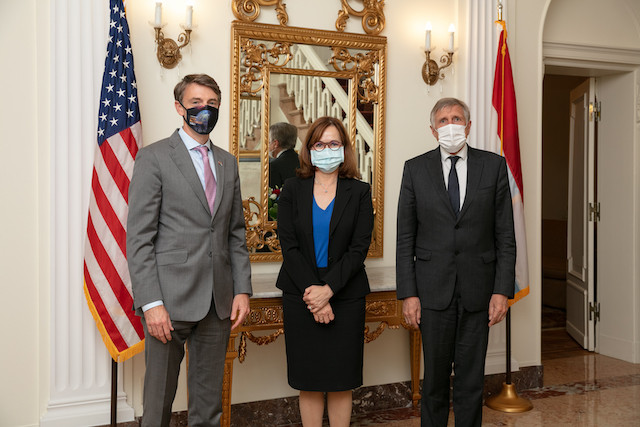Kelli L. Seybolt, US deputy undersecretary of the Air Force’s international affairs office, visited Luxembourg on Thursday and Friday to meet with government officials and private space sector players. Space Force is a branch of the Air Force.
“I don’t envy the problem,” she said speaking to Delano about Luxembourg struggling to meet its Nato commitments. Alliance members in 2014 pledged to spend 2% of GDP on their militaries, a challenge for the grand duchy’s small army of 400 active soldiers.
In 2019, Luxembourg would have had to spend €1.2bn on defence to meet the 2% pledge. It spent around €395m on its military. A slew of investments, including in space, is helping raise the sum from 0.6% of GDP to 0.72% by 2024.
“Luxembourg has some really great capabilities, particularly with space,” Seybolt said. “And that’s an area that’s not a low cost-of-entry sport.”
Parliament in November 2020 agreed to spend an extra €139m on an Earth observation satellite operated by Luxembourg’s military, raising the total budget to €309m. The satellite will supply high resolution images of the Earth’s surface to Nato, the UN and other allies, for example to provide intelligence on conflict zones. “That will be very interesting to us to look at and see how we might collaborate,” Seybolt said.
This could happen in the framework of the US Space Force, which wants to increase its international collaboration, the US official said. “We’ll be looking at our space architecture, adding in our allies and partners.” The Luxembourg satellite could “fit into that coalition architecture.”
Luxembourg already is a partner on the Wideband Global Satcom system, the backbone of the US military’s global satellite communications, now under Space Force control. The grand duchy co-funded the ninth satellite in the system, together with Canada, Denmark, the Netherlands and New Zealand.
Seybolt met with defence minister François Bausch (déi Gréng) on Thursday to discuss expanding Satcom cooperation.
In June, Luxembourg committed €6.7mn to help Nato develop its space situational awareness capabilities to detect and identify objects in space as the orbit around Earth becomes more congested. “It’s really a critical foundational capability,” Seybolt said about the initiative, emphasising Luxembourg’s role in providing support for larger partners.
Private sector as space partner
Luxembourg in 2019 signed a space cooperation agreement with the US, aimed at promoting space industries and strengthening policy and scientific coordination. Last October, the country became a founding signatory of the Artemis accords, paving the way for a Moon to Mars mission. And Nasa chose Japanese-Luxembourg company ispace to collect lunar resources starting 2023.

Kelli L. Seybolt, US deputy undersecretary of the Air Force’s international affairs office
This convergence of the public and private sectors is playing a role in science and exploration but will also have a growing defence dimension, Seybolt said. “The commercial space industry is what’s really growing at an incredible pace,” she said. SpaceX and other innovators have made access to space cheaper, she said, also for governments. “There are areas of overlap and collaboration.”
One of these areas is satellite communications, with an entire branch of Luxembourg satellite operator SES--SES Government Solutions, or SES GS--working exclusively with US government clients.
The subsidiary has long been a bone of contention between the state, as an SES shareholder, and opposition parties like déi Lénk who have criticised Luxembourg’s implicit support for predator and reaper drone missions carried out by the US using SES capacity.
“We’re really exploring how we can deepen and do more cooperation,” Seybolt said about SES. During her visit to Luxembourg, she also met with SES CEO Steve Collar. “That’s the focus of this trip, not other companies,” Seybolt said.
A planned visit by the chief of space operations, General John W. Raymond, could yield other partners. “He does see commercial space as an area of innovation where they can move faster, in some ways, than we can on the military side.”
Green ally, small market
As Luxembourg redefines its security role--and with a Green defence minister--it is also looking to spend more money on climate-friendly defence projects. It is replacing civilian vehicles with hybrid or electric models as well as refurbishing military barracks and a shooting range to reduce pollution.
“There’s definitely opportunities there,” Seybolt said about Luxembourg’s push for a greener future of the defence sector. “The Air Force is one of the biggest fuel consumers in the US for aviation fuel,” she said, adding that it has been looking at hybrid fuel solutions. “We’re up there on that, looking for ways to be more efficient, effective, greener,” she said. “The administration is placing an emphasis on climate and coming back into that.”
Nato chief Jens Stoltenberg in a September 2020 speech said Nato “must help curb climate change” because “climate change is making the world unsafe.” A strategic review to set the organisation’s 2030 agenda is currently underway and Luxembourg is pushing for climate issues to be systematically included in security and defence efforts.
Seybolt as part of her role also helps connect US defence companies and foreign governments. “We would welcome to talk to Luxembourg about areas of interest with things that the United States produces,” she said about military spending.
Bausch in January said the military is planning on buying drones to expand its intelligence, surveillance and reconnaissance capabilities but that there were no concrete plans yet. A fleet of 80 command, liaison and reconnaissance vehicles worth €367m will be purchased through the Nato Support and Procurement Agency.
“US companies would be interested in any ability to support Luxembourg. I’m sure they would see that as a small but important market,” Seybolt said.
